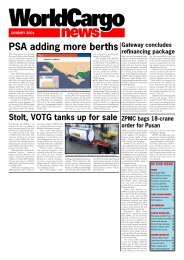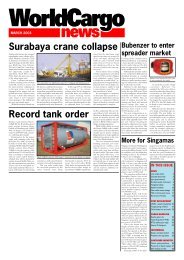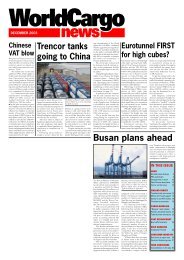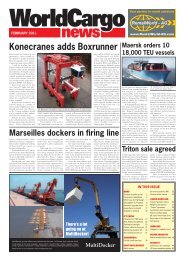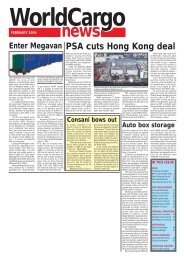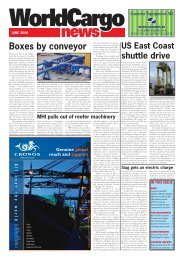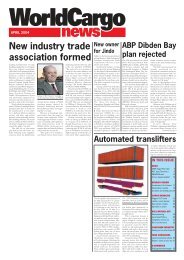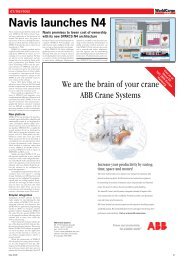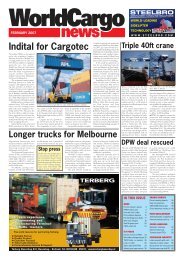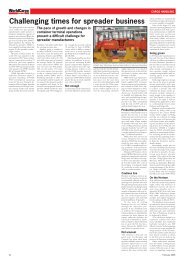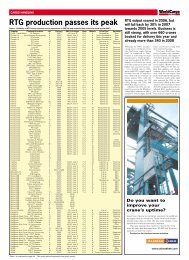US-built box crane - WorldCargo News Online
US-built box crane - WorldCargo News Online
US-built box crane - WorldCargo News Online
You also want an ePaper? Increase the reach of your titles
YUMPU automatically turns print PDFs into web optimized ePapers that Google loves.
PORT NEWS<br />
Auckland cuts the glare<br />
In many parts of the world ports<br />
and terminal operators are under<br />
pressure to cut “light pollution”<br />
and save energy in the process and,<br />
indeed, in some areas this is a major<br />
priority ranking alongside<br />
noise, air quality and other environmental<br />
nuisances.<br />
Philips has completed the largest<br />
outdoor installation of its<br />
OptiVision Floodlighting lighting<br />
system to date at Ports of Auckland<br />
Ltd (POAL) in New Zealand.<br />
After an energy efficiency audit<br />
identified lighting as an area where<br />
the port could cut energy use,<br />
Philips’ lighting engineers recommended<br />
redesigning the port’s<br />
lighting system and replacing 1300<br />
older style floodlights with 670<br />
new OptiVision asymmetrical<br />
floodlights. These use the same<br />
1000W metal halide lamps but<br />
focus light much more effectively,<br />
producing 10 times less light spill<br />
outside the port area.<br />
OptiVision features asymmetric<br />
optics designed to achieve peak<br />
intensity at 600 and a sharp back<br />
light cut off of light at 800. Philips<br />
NZ’s national sales supervisor Brian<br />
Brandford explains that in the<br />
POAL environment both horizontal<br />
and vertical illuminance has<br />
to be considered as truck drivers<br />
and ground workers are looking<br />
ahead while straddle <strong>crane</strong> drivers<br />
are predominantly looking<br />
down. Tests in an operational area<br />
showed that OptiVision could<br />
provide better light with fewer<br />
lamps - lux measures increased<br />
from 25 to 60 lux average.<br />
Although “spill” outside the<br />
port operational area has been reduced,<br />
the main complaint about<br />
Auckland’s existing lighting was<br />
Nightscape of POAL’s Axis Fergusson container terminal before (above) and<br />
after the Philips OptiVision installations. Note the marked reduction in<br />
“scattering” above the light poles<br />
glare, both from vantage points<br />
looking over the port out towards<br />
the water and from the north side<br />
of the harbour looking towards<br />
the CBD behind the port.<br />
Reduction in glare is much<br />
more difficult to measure but the<br />
accompanying images show a visible<br />
improvement and Auckland<br />
City’s CBD projects team has<br />
endorsed the upgrade, noting that<br />
nightscapes are now much clearer<br />
from main vantage points. The<br />
port itself says the reduction in<br />
glare has made berthing at night<br />
easier for pilots and tug operators.<br />
Philips was able to reuse existing<br />
control gear, cabling and other<br />
infrastructure and reduce the<br />
number of lighting towers. The<br />
project cost NZ$900,000 and<br />
POAL expects to recoup this<br />
within three years through a 15<br />
per cent reduction in power consumption.<br />
The energy audit also<br />
identified that power usage could<br />
be cut by a further five per cent<br />
by installing power factor correction<br />
equipment in the two main<br />
substations at the port.<br />
New landlords take office<br />
Nigeria has taken another step in<br />
its port reform programme with the<br />
formation of the Lagos Ports and<br />
Harbours Authority (LPHA) and<br />
Niger Delta Ports and Harbours<br />
Authority (NDPHA), which have<br />
been set up in time to hand over<br />
port control to the successful bidders<br />
in the concession process.<br />
The two authorities will be<br />
regional regulators, acting as port<br />
landlords and overseeing the work<br />
of the concessionaires to be appointed<br />
to manage the various<br />
ports and terminals within their<br />
jurisdictions. The LPHA and<br />
NDPHA, which are staffed by<br />
former Nigerian Ports Authority<br />
(NPA) employees, are to finalise<br />
the details of the contracts to be<br />
offered to private sector bidders.<br />
The creation of the two authorities<br />
is part of the overall<br />
shake-up of the country’s port<br />
regulatory structure. The NPA will<br />
PSA-HNN and a consortium of<br />
K-Line, Yang Ming and Hanjin<br />
(KYH) are forming a joint venture<br />
company, Antwerp International<br />
Terminal NV, to operate multiple<br />
berths at PSA-HNN Deurganckdok<br />
Terminal in Antwerp with effect<br />
from next January.<br />
The lines are long-standing<br />
customers of PSA round the world<br />
and the joint venture is an important<br />
step, says PSA-HNN,in further<br />
strengthening their partnership.<br />
Antwerp will become the<br />
European hub for KYH to handle<br />
its rapidly expanding Far East-<br />
Europe trade.<br />
continue to act as the national<br />
regulator and the federal government’s<br />
watchdog for the entire<br />
sector, as the government seems<br />
to have reversed its original recommendation<br />
that a separate<br />
regulator should be set up.<br />
The new authorities cover the<br />
two most important shipping areas<br />
in the country. The Lagos ports<br />
of Apapa, Lagos and Tin Can Island<br />
handle 70-75 per cent of all<br />
Nigerian trade, while the<br />
NDPHA will act as landlord for<br />
the Port Harcourt ports that serve<br />
the country’s large and growing<br />
oil and gas sector.<br />
● A scheme has been proposed to<br />
open up the Port of Ikot Abasi,<br />
which currently only serves the<br />
aluminium industry, to the wider<br />
business community (cf flour milling).<br />
Ikot Abasi lies at the mouth<br />
of the River Imo in the eastern<br />
Niger River Delta. It is the only<br />
PSA-HNN inks new<br />
deal in Antwerp<br />
PSA-HNN plans to invest<br />
more than €500 mill in the next<br />
five years to double its terminal<br />
capacity to more than 10 mill<br />
TEU/year at all its riverside terminals<br />
in Antwerp - Europa and<br />
Noordzee on the right bank as<br />
well as Deurganck Terminal on the<br />
left bank.<br />
“This KYH-PSA joint venture<br />
cements PSA’s long time business<br />
relationship with KYH, and signifies<br />
the beginning of a new partnership<br />
to meet the changing<br />
needs of KYH and its customers,”<br />
said Pierre Timmermans, CEO of<br />
PSA Europe.<br />
port in Akwa Ibom state, although<br />
the state contains three export<br />
processing zones, and has served<br />
the Aluminium Smelter Company<br />
of Nigeria (ALSCON) since it was<br />
completed in 1997.<br />
Also in the Delta area, the federal<br />
government is seeking to restart<br />
construction work on the<br />
Port of Onitsha. Work on the half<strong>built</strong><br />
facilities was suspended in<br />
1983 following the change of government<br />
but a site survey has revealed<br />
that the original works can<br />
be retained.<br />
Luanda set to expand<br />
The Angolan government hopes<br />
that a fourth terminal can be developed<br />
at the port of Luanda to<br />
cater for the needs of the growing<br />
oil and gas sector as part of<br />
the modernisation of the entire<br />
port. Much of the country’s infrastructure<br />
is in a dilapidated<br />
state after over a quarter of a century<br />
of civil war, but it is believed<br />
that a combination of donor support<br />
and Angola’s growing hydrocarbon<br />
revenues can fund the rehabilitation<br />
of rail and port infrastructure.<br />
The government and the<br />
World Bank have carried out a<br />
study to identify the best strategy<br />
for modernising Luanda’s existing<br />
facilities, improving port efficiency<br />
and building the new terminal.<br />
Large scale spending on <strong>crane</strong>s and<br />
other machinery should comprise<br />
a large proportion of the new investment.<br />
The minister of transport,<br />
Andre Luís Brandão, says that<br />
the investment is required to at<br />
least bring Luanda up to the standards<br />
of Africa’s other main ports.<br />
APM Terminals is now one<br />
<strong>WorldCargo</strong><br />
news<br />
year into the 20 year contract it<br />
won to operate Luanda’s container<br />
terminal. Under the terms of the<br />
deal, the company must invest<br />
<strong>US</strong>$55 mill by 2009 in increasing<br />
the terminal’s capacity from<br />
200,000 TEU to 300,000 TEU a<br />
year. After improving the quay<br />
area, the company is expected to<br />
invest in new cargo handling<br />
equipment, including one mobile<br />
harbour <strong>crane</strong> and two gantry<br />
<strong>crane</strong>s. However, APM has spent<br />
much of the first year of its concession<br />
removing wrecked vessels<br />
from the harbour and dredging<br />
both the harbour and the approach<br />
channels.<br />
September 2005 13



